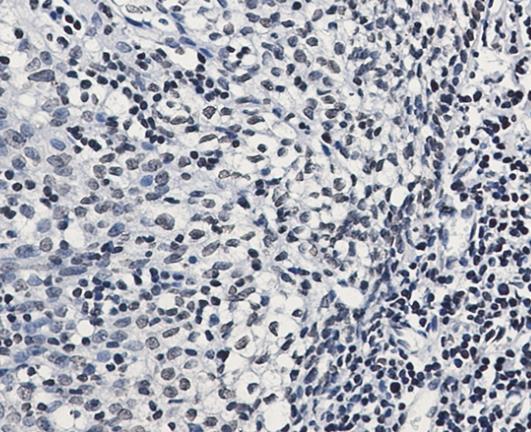Product Detail
Product NameGlucocorticoid Receptor (Phospho-Ser226) Rabbit mAb
Clone No.S02-1H0
Host SpeciesRecombinant Rabbit
ClonalityMonoclonal
IsotypeIgG
PurificationAffinity Purified
ApplicationsWB,IHC
Species ReactivityHu,Rt
Immunogen DescA synthetic phosphopeptide corresponding to residues surrounding Ser226 of human Glucocorticoid Receptor
ConjugateUnconjugated
Other NamesGR; GCR; GRL; GCCR; GCRST
Accession NoSwiss-Prot:P04150
GeneID:2908
Uniprot
P04150
Gene ID
2908
Calculated MWPredicted band size: 86 kDa
Sdspage MWObserved band size: 94 kDa
Concentration0.3 mg/ml
Formulation50mM Tris-Glycine(pH 7.4), 0.15M NaCl, 40% Glycerol, 0.01% Sodium azide and 0.05% BSA
StorageStore at 4˚C short term. Aliquot and store at -20˚C long term. Avoid freeze/thaw cycles.
Application Details
WB: 1:500-1:2000
IHC: 1:50-1:200
All lanes : Glucocorticoid Receptor (Phospho-Ser226) Rabbit mAb at 1/1k dilutionLane 1 : Hela whole cell lysatesLane 2 : Hela treated with UV for 15min whole cellLane 3 : C6 whole cell lysatesLane 4 : C6 treated with UV for 15min whole cell lysatesLysates/proteins at 20 µg per lane.SecondaryAll lanes : Goat Anti-Rabbit IgG H&L (HRP) at 1/20000 dilutionPredicted band size: 86 kDa Observed band size: 94 kDaExposure time: 8 seconds
Formalin-fixed, paraffin-embedded human tonsil tissue stained for Glucocorticoid Receptor (Phospho-Ser226) using 52695 at 1/100 dilution in immunohistochemical analysis.
This gene encodes glucocorticoid receptor, which can function both as a transcription factor that binds to glucocorticoid response elements in the promoters of glucocorticoid responsive genes to activate their transcription, and as a regulator of other transcription factors. This receptor is typically found in the cytoplasm, but upon ligand binding, is transported into the nucleus. It is involved in inflammatory responses, cellular proliferation, and differentiation in target tissues. Mutations in this gene are associated with generalized glucocorticoid resistance. Alternative splicing of this gene results in transcript variants encoding either the same or different isoforms. Additional isoforms resulting from the use of alternate in-frame translation initiation sites have also been described, and shown to be functional, displaying diverse cytoplasm-to-nucleus trafficking patterns and distinct transcriptional activities (PMID:15866175). [provided by RefSeq, Feb 2011]
If you have published an article using product 52695, please notify us so that we can cite your literature.




 Yes
Yes



